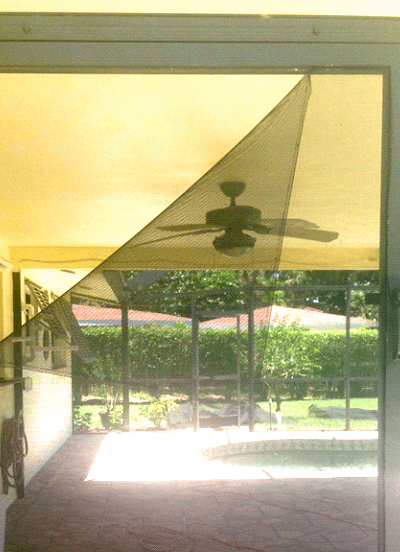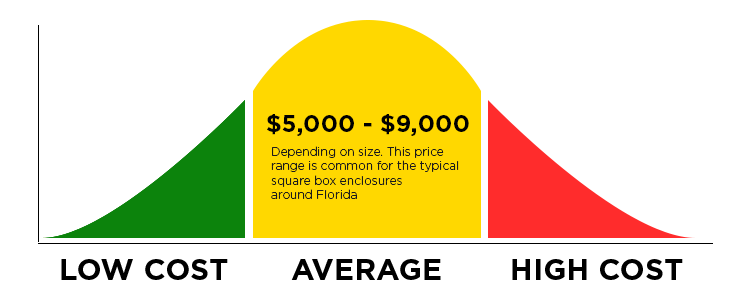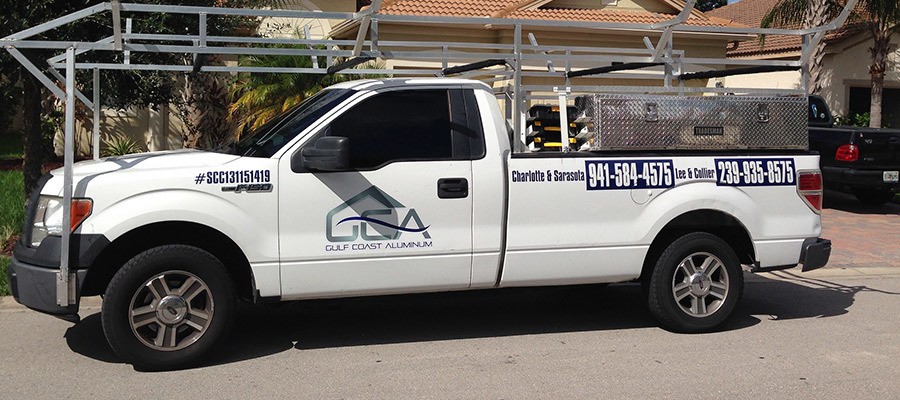When is Time
to Restore
A Screen Enclosure
You are the proud owner of a screen enclosure. You host pool parties, barbeques, enjoy wine and bug free evenings under the stars, as well as many other outdoor activities for family and friends. The screen enclosure comes in mighty handy! However, you are also the primary caregiver for this awesome structure, which entails a bit of work. It requires maintenance, repairs, restoration and renovations, just as all physical structures do. Many people don’t realize this when they purchase a home with a screen enclosure, or invest in one to add value to their home. But, it’s ok. We’re here to help!

The primary problem with pool cages is that most are manufactured in a builder’s grade. Meaning they use low quality and inexpensive screen and building materials to keep their cost down, and their bottom line up. The outcome? You get fasteners that rust quickly, screen that tears easily, and epoxy paint that turns green. But when it is time to restore and renovate the enclosure?
Consider the Life of the Screen
As we discussed, unless you consciously selected higher grade materials for your screen enclosure on your own terms with your own contractor, you most likely bought your home with a preexisting structure with builder’s grade quality products. To put things into proper perspective, the average commercial home builder such as Lennar and GL Homes, uses Artisan screen, which only lasts 3-5 years. You could replace panels screen by screen as they deteriorate, but you will notice a difference in color from new to old, and more tears are likely to soon follow. You will also pay a service charge each time an expert comes out to service the property. In other words, you get more screen for your dollar when you do a full re-screen.
Consider the Structure’s Fasteners
With exposure to water, salt, concrete, and different metals, the builder’s grade steel screws usually rust and become quite weak in a matter of just a few years. Sure, you can just go ahead and replace the fasteners all at once without a rescreen, but you know what? By the time the workers maneuver their equipment carefully around the cage to not damage any screen, they could have changed the screen and bolts in entirety. A huge discount is offered on projects for this reason alone. With an entire restoration, your screen and fasteners can be replaced for a much better price than doing each separately.
How Often do your Paint your Home?
Did you know that It is recommended that you repaint your home every 5-10 years to keep the appeal and integrity of the house? Sometimes deed restricted home owner associations even mandate it! Your screen enclosure should be treated the same way, and actually, it uses the same paint. Unfortunately, with the low grade epoxy paint most likely used by the builder, you will notice fading color and/or a green color change once the structure hits the 5 year mark. Very often, home owners proactively attempt to repaint the home and the screen structure all at once. But to no avail, as house painters are not the best choice for the enclosure.
- Paint doesn’t easily bond to aluminum as metal is one of the trickiest surfaces to paint, and in areas of corrosion, proper steps must be taken to prepare these areas for a refinish. Specialty paint that comes with a powder coat such as 2604 is used.
- For the highest quality finish free from streaks, the paint can’t be applied with a roller. It must be sprayed on using specialized equipment, trained professionals, and special attention to overspray. Thoroughly masking and covering the surrounding surfaces is extremely important and requires knowledge.
- Last but not least, to paint the enclosure in full, the screens need to be removed. Exclusive painting companies do not have the experience to do this. You will want a company that specializes in restoring and renovating screen enclosures.
If you are in need of new screen, new fasteners, or a repaint, you may want to consider an entire restoration and renovation, as this you will get the best deal for your money. Conducting each project individually will be result in additional funds and time restraints. You will also be given better quality paint, screens and fasteners, prolonging the life of your investment.
What Does
A Restoration
Include?
If you’ve been noticing the screens to your enclosure fading, coming loose, or breaking, and the structure itself turning green, and most likely the majority of the fasteners rusting away, it may be time for a complete restoration. Believe it or not, it is much more cost effective, and faster as we describe in another cheaper.

Screen enclosure restoration has become one of our most popular services. In fact, we have perfected the process, and last year alone we painted over 200 cages. You will be pleased to know that a restoration includes everything to make your screen enclosure look as if it was brand new, and it only takes a couple of weeks!
A Standard Restoration Includes:
- New Screen
All the old screen from your enclosure will be removed and properly disposed of, then rescreened with a high quality nylon screen of your choice. - Fasteners
Every single fastener (99.9% of them) is upgraded during the restoration process. The reason is- It restores strength to the enclosure
- To ensure a long lasting paint finish and
- It is 40% less expensive to replace the fasteners while the other work is being conducted.
Enclosures are all designed to withstand the wind capacity at the time they were built, however, the most common steel fasteners loose over 50% of their strength within the first year, leaving the structure incapable of withstanding the original wind capacity it was designed for.
Nylo-tech fasteners will be used during the restoration as they give a finish that stands the test of time. Other steel based fasteners rust underneath the paint creating problems and accelerating paint deterioration. - Repainting
This is the big one! Prior to the painting, the enclosure is thoroughly cleaned and intricately prepared for painting. Each job requires careful accommodations to cover the pool, walls and floor of the patio to ensure no paint stains are left behind. This is a perfected art, and an extremely important element of the job in itself. The highest quality acrylic DTM paint is used to withstand the harsh Florida elements, and give the cages a 10-12 year life span. No lines or streaks are left behind as commercial grade sprayers apply the precise amount to guarantee a flawless finish. - Door kits
People are often shocked to find out that door kits that the changing of the door kits is generally included. All hardware and latches are changed despite of condition to match the newness of the entire screen enclosure.
In addition to a standard restoration package, many opt to add additional products such as hurricane cables or an upgraded screen grade :
- Hurricane Cables
If you live in the sunny State of Florida, you are well aware of the hurricane season, and the dangers it presents along with it. But did you know that screen enclosures are often the very first item that damages during the storm? If not properly maintained, screens will tear, bolts will unfasten, and believe it or not, entire enclosures have gone down. Hurricane cables are an extra level of security keeping the enclosure intact, more wind resistant, and sturdy. They are definitely a great choice in Florida. - Upgraded Screen
Although standard vinyl Phifer screen is the top of the line fiberglass screen and also hurricane resistant (if the aluminum structure is engineered accordingly), many homeowners choose to upgrade to polyester, such as Super Screen or Ultra Screen. This are another option for proactively preparing for hurricane season as they are more resistant to high winds than standard fiberglass Phifer 18/14 screen The polyester screens are inherently stronger with a ball burst strength test rating of 180 – 190 lbs. The polyester screens are warrantied against tears for 10 years. They are also great for pet owners who need additional strength in their screens.
Once all these steps are complete, your restoration will leave your screen enclosure looking as if it were brand new.
How Much
Does a Screen Enclosure
Restoration Cost?
Now we will discuss the important stuff. How much does a screen enclosure restoration actually cost? The word “restoration” often insinuates an output of a great deal of money, and can scare many homeowners away. But, in reality, it is the most cost efficient method of maintaining your property and keeping the structure safe and intact.


Average CostBottom line, the average cost of most screen enclosure restorations average between $5,000 – $9000, depending on size. This price range is common for the typical square box enclosures around Florida about 25’ x 50’ in size and 10’ high (Notice: No estimate or guarantee of price is made. Please contact us or a local contractor to get a specific quote). Large and more complex enclosures, may run significantly higher. The largest one we have ever seen completed was around $40,000. While it does sound expensive, all things are relative and a replacement of that screen would’ve costed about $120,000.
The restoration includes: a re-screen with top quality vinyl mesh, repainting with the highest quality acrylic DTM paint, door kits, and replacing all the existing fasteners with Nylotech fasteners for strength and durability. This also includes professional preparation to ensure there are no paint stains left behind, cleanup and disposal of all old screen and materials, as well as 3 year full warranty on all parts and labor.
Restoration Vs ReplacementReplacement of the entire screen enclosure, from bottom up usually costs about twice the amount of a full restoration. On average, a restoration of the structure usually costs 40-50% less than replacing it. The price difference is accentuated even further really large screen enclosures where the replacement cost can come in well above $50,000. Therefore, if given the choice between the two, a restoration is usually the best choice. You can truly see the value on savings between a restoration vs replacement with extremely large enclosures, as the price difference and savings is even further increased with the restoration being much more economical. Once completed, a restoration looks just as fantastic as a brand new structure.
TimelineHere is where the true savings occur! Measured in time! For those of you who use your screen enclosure often, you will feel the difference between a restoration and a replacement when it comes time. Restorations do not require permits or engineering and are placed directly into the work queue averaging completion about in about two week. For a replacement of the entire structure, homeowners would be looking at a completion date of 2-3 months, in the least. If you frequent your screen enclosure, and use it often, this may be an inconvenience.
When broken up over the 10 year time span that a restoration is suggested to last, the cost of a restoration really is a minor expense for the maintenance of this external structure adjoining your home.
How Long
Does it Take to Complete a
Pool Enclosure Renovation?
You’re in luck! A screen enclosure is very time efficient from start to finish. Weather permitting, most projects can be completed within 2 weeks, as there are no permits or engineering required. With our strong base of professional workers, most projects are placed in the queue and started with in a week or so. There are however some factors that can affect the time schedule. Being based in Florida, the weather must be taken into consideration as a screen enclosure simply cannot be painted in the rain or wind. With the Florida summer weather, and it’s frequently occurring tropical thunderstorms, often times there are delays during this season, however experience contractors in Florida are used to dealing with these. There are also additional time requirements with large enclosures.
First, the entire screen and all the old fasteners are is removed and disposed of. This procedure usually takes about 2 hours total.
All fasteners are then changed using Nylotech fasteners which give a finish that stands the test of time, and never rusts or deteriorates beneath the fresh paint. Changing the fasteners usually takes 1-2 days depending on the size of the enclosure.
The structures is then cleaned and prepped very heavily, which usually takes about a half of a day. Everything surrounding the structure beams are thoroughly covered with plastic sheeting, including the house walls, porch floor and the pool and the finer details are taped off with painters tape.
The screen enclosure is the painted with the highest quality acrylic DTM paint, usually taking 1-2 days, depending on weather and the size of the structure.
The there is a 3 day waiting period for paint to dry completely.
Last, the new screens are replaced using either the vinyl mesh or polyester upgrade, whichever the homeowner prefers. Replacing the screens usually takes about 1-2 days.
Luckily, a screen enclosure renovation only takes a small amount of time complete. The most common question we are asked is whether the pool can be used at this time, and the answer is, no. Unfortunately, the pool and the enclosure will be off limits for usage during this time as there will be lots of tools, ladders, and scaffolding around the deck, but optimistically speaking, you should have it back in not time!
Choosing a
Contractor for
Screen Enclosure Restoration
Upon your decision to restore your screen enclosure, next you must choose the right company for the job. Although it seems convenient and practical to just hire the same company to paint your home and screen enclosure simultaneously, it isn’t the best choice. Painting the screen enclosure requires a specialty company. One who can change and paint the enclosure fasteners, and remove and add the new and old screen. Not to mention, that the metal of the screen is so oddly shaped with ridges, it takes special equipment to complete the job. Metal itself is a hard property for paint to adhere to. Most paint companies do not possess the skills to paint this type of surface. For the best results, you will want a professional, experienced, and licensed company to complete the job.


Our suggestions? Interview a couple of companies, and choose the best one. You may find cheaper and lower bids, but you will want to look deeper than that, and here is why:
- For the ultimate paint job, you will want to hire experienced painters. The screen enclosure consists of a tough metal for paint to adhere to, and very complex 4 sided beams, unlike the wall of a home.
- They must be licensed. Check for a state contractor’s license on every company that you interview. Visit the Department of Business and Professional Regulations (DBPR) to ensure the company is legally registered and up to date.
- Make sure the company is fully insured, and ask to see the actual insurance certificate issued by the agent showing the coverage. Trust us on this one! A legitimate company will have NO problem sharing these documents with you.
- Check for Fly-by-Nights or inexperienced companies. How do you do this? Quite simple. Check for an actual physical office, as this means they are more likely here to stay in business. Check on their reputation by searching for online reviews, and then double check those review are real! You can also find great information on the Better Business Bureau (BBB) website. Fly-by-Night and inexperienced companies are more likely to lose deposits, not file the proper paperwork for permits and legal documents, leave jobs incomplete due to lack of proper funding, and experience major delays in the project completion time. They often hire pay by day labor who are inexperienced and often times unreliable.
- Know the truth about the pool enclosure price tag, and shop on reputation. Meaning, there will be a variety of price quotes given to as you search for the best company, but do just that. Choose the best company. Base your decision on raving reviews about quality work and professionalism. Yes, there may be cheap and low bidding, but understand, many companies will do whatever it takes to get the job, but be unable to follow through with their promises, leaving customers unsatisfied with low craftsmanship, poor quality paint jobs, disorganization, lack of a proper labor pool and delayed time frames. These companies are highly unlikely to provide any warranties and highly likely to cause headaches.
In summary, when choosing a company for the restoration of your screen enclosure, make sure you hire experienced painters, ensure the company has proper insurance and licensing by seeing proof of documentation, check their reviews and corporate status on DBPR, BBB and Google, and conduct a check on whether the company seems sturdy of “fly-by-night” . When all these have a checked out, to ensure the best quality and professional job for your home improvement project, shop via reputation, and not price tag.





